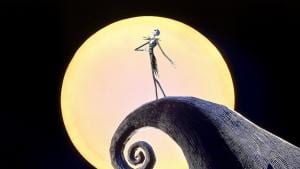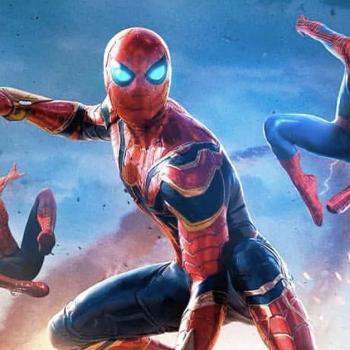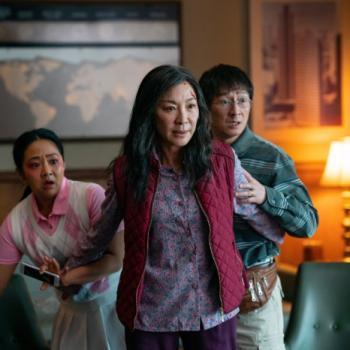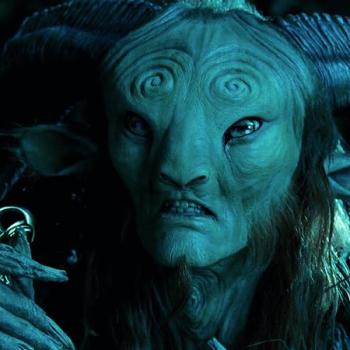
A few days ago, my wife and I dropped by our mostly-empty neighborhood movie theater to take in Tim Burton’s bizarre little ‘90s flick, The Nightmare Before Christmas. (Sure, it’s also on Disney+, but if you have a month-to-month AMC membership, might as well go for the big screen!)
If you’ve never seen the movie, it’s worth noting that no one can accuse Nightmare of unoriginality. (I, for one, can’t think of another gothic stop-motion musical mashup that cribs heavily from both Rudolf the Red-Nosed Reindeer and How the Grinch Stole Christmas.) In a nutshell, Nightmare tells the story of what happens when the head of goblin-infested “Halloween Town,” our existentially depressed protagonist Jack Skellington, strays into the adjacent “Christmas Town” shortly after putting together yet another successful Halloween for the world. Struck by Christmas Town’s radically different ambiance and culture, Jack resolves that Halloween Town will handle the responsibilities of Christmas that year, and goes so far as to kidnap Santa Claus and turn him over to the malignant horror “Oogie Boogie.”
Unsurprisingly, of course, the substitute holiday is a total disaster: Halloween Town’s residents are utterly unable to capture Christmas Town’s joyous mood, or to conceive of presents as anything other than vehicles for scares. Panic over Jack’s ghoulish Christmas sweeps the world. Jack’s knockoff “sleigh” is shot out of the sky with antiaircraft guns, leaving Jack to limp home just in time to save his friends from Oogie’s threats.
All in all, it’s a weird—and yet weirdly charming—little movie, with memorable art design and an infectious soundtrack. The film’s ending, in particular, is distinctive: unlike what you might expect from a modern children’s film, it doesn’t depict the unification of Halloween Town and Christmas Town. Rather, Halloween Town becomes more fully itself, more aware of its own strengths and what it has to offer the world, and vice versa.
This coda underscores one of the movie’s particularly intriguing themes: the disastrous effects of trying to appropriate the aesthetics of Christmas without an understanding of their meaning or context.
In one of the movie’s best sequences, Jack struggles to figure out the “meaning of Christmas” by dropping ornament fragments into test tubes, trying to figure out how “sugar plum visions” fit into a Christmas equation, and what makes Santa’s reindeer fly. I find it funny in part because, consciously or not, we’re all familiar with people who share this sort of approach to the world. The scene recalls a certain kind of scientistic huffing and puffing, exemplified by much of Neil deGrasse Tyson’s Twitter feed, about how “love is just chemicals” or “prayer is just neural activity in the brain.”
Almost no one would disagree that conscious events have ascertainable physical correlates, but accounts like Tyson’s cannot possibly explain what those experiences mean. If love is nothing more than a dopamine hit, why praise fathers who rush into burning buildings to save their children, rather than those who spend their days shooting up heroin? Put succinctly, physical facts only become relevant to human action within an interpretive framework that mere empirical observation does not provide. And that interpretive framework is what I and others call “tradition.” (Crucially, there’s no possibility of standing outside such an interpretive framework: we are born into and educated within one.)
In Nightmare, it seems that “Christmas” is not just an aesthetic; it is rather a way of life, a tradition, that someone not committed to participation in that tradition cannot comprehensively understand. Jack’s abortive attempt at “Christmas” depicts the ugliness that can result from ripping the outward expressions of a tradition out of their proper context of meaning. The chief symbol of Christmas that Jack grasps—the wrapped present—is wrongly interpreted by Halloween Town’s denizens as merely a mystery box concealing monstrosities. On Halloween Town’s interpretation, the wrapped present’s true meaning of love and self-sacrifice is totally lost.
This, I think, illuminates an area where today’s critics of “cultural appropriation” really do have a point: where physical objects are deeply charged with meaning within the context of a given tradition, it displays a distinct contempt for that tradition to use those objects and symbols for alien ends. If you, like me, are a Christian from a sacramental tradition, would you really feel comfortable with a church-themed restaurant, featuring waiters in cassocks and stoles, handing out baskets of wafers and glasses of wine as a pre-dinner snack food?
This is not to problematize every form of cultural exchange, because not every item or practice within a given tradition of thought is “thick with meaning,” so to speak. (For instance, as I understand it, there is a significant “meaningfulness” gap in Japanese culture between the traditional tea ceremony and, say, a sushi roll—though I would welcome correction if I am mistaken.) Rather, it is to acknowledge that some such items and practices are the linchpins of ways of life that may not be immediately accessible to those inhabiting alternative traditions. And preserving the beauty of those ways of life is a worthwhile endeavor.
Nor is this analysis meant to suggest that participants in different traditions are condemned to endlessly jockeying for speaking time, without the possibility of real interaction or engagement. Rather, living traditions grow and evolve as they confront rival paradigms, as inhabitants begin to test the boundaries of their frameworks and figure out points of common ground expressed in different vocabularies.
Nightmare’s ultimate vision, happily, is no different. In the final shot of the film, Jack kisses his longtime sweetheart under a spooky full moon—and yet kissing is a practice first glimpsed in Christmas Town, seen nowhere else in Jack’s homeland. It is an indication that something is different now in Halloween Town, that something novel has entered the socio-moral landscape without destabilizing it completely. Perhaps in the act of self-sacrifice, in risking his own life to fight Oogie and his henchmen at the film’s climax, Jack genuinely begins to experience a tradition of self-giving that was not previously his own—and in that experience, finds the resources that allow him to love another person, and so overcome his own prior alienation as leader of the town. Or, if you prefer, Jack finds the “spirit of Christmas” within the confines of Halloween Town, yet without blurring one into the other.
That, to my mind, makes for a very interesting story.












